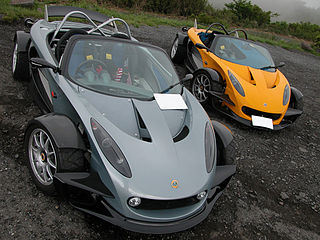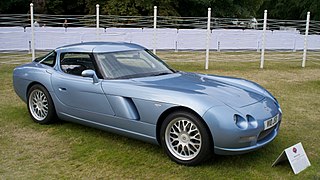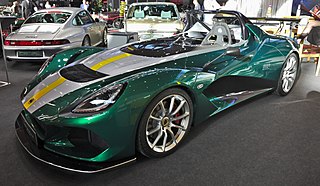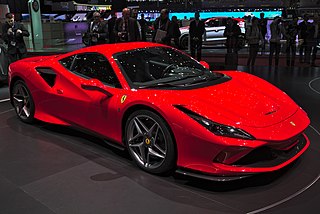Related Research Articles

The Lotus Elise is a sports car conceived in early 1994 and released in September 1996 by the British manufacturer Lotus Cars. A two-seater roadster with a rear mid-engine, rear-wheel-drive layout, the Elise has a fibreglass body shell atop its bonded extruded aluminium chassis that provides a rigid platform for the suspension, while keeping weight and production costs to a minimum. The Elise was named after Elisa Artioli, the granddaughter of Romano Artioli who was chairman of Lotus and Bugatti at the time of the car's launch.

The Lotus 340R is a limited edition sports car manufactured by Lotus Cars in 2000 at their Hethel factory.

The Caterham 7 is a super-lightweight sports car produced by Caterham Cars in the United Kingdom. It is based on the Lotus Seven, a lightweight sports car sold in kit and factory-built form by Lotus Cars, from 1957 to 1972.

The TVR S series is a line of sports cars manufactured by the British company TVR between 1986 and 1994. It was announced at the 1986 British International Motor Show. The car went into production in less than 12 months, with 150 pre-manufacture orders placed at the motor show before the moulds were even made.

The RB engine is an oversquare 2.0–3.0 L straight-6 four-stroke gasoline engine from Nissan, originally produced from 1985 to 2004. The RB followed the 1983 VG-series V6 engines to offer a full, modern range in both straight or V layouts. It was part of a new engine family name PLASMA.

The Lotus Exige is a sports car made by the British company Lotus Cars from 2000 until 2021. Originally a coupé version of the Lotus Elise roadster, since the Series 3 the Exige has been the larger-engined model of the family, featuring a V6 engine in place of the Elise's straight-four. Convertible versions of both models are available.

A multi-valve or multivalve engine is one where each cylinder has more than two valves. A multi-valve engine has better breathing, and with more smaller valves may be able to operate at higher revolutions per minute (RPM) than a two-valve engine, delivering more power.

The Bristol Fighter is a sports car produced by Bristol Cars in small numbers from 2004 until the company suspended manufacturing in 2011. It is generally classed as a supercar.

The Aston Martin Vantage is a series of hand-built sports cars from the British automotive manufacturer Aston Martin. Aston Martin has previously used the "Vantage" name on high-performance variants of their existing GT models, notably on the Virage-based car of the 1990s. The modern car, in contrast, is the leanest and most agile car in Aston's lineup. As such, it is intended as a more focused model to reach out to potential buyers of cars such as the Porsche 911 as well as the exotic sports and GT cars with which Aston Martins traditionally compete.

Alpina Burkard Bovensiepen GmbH & Co. KG is an automobile manufacturing company based in Buchloe, in the Ostallgäu district of Bavaria, Germany that develops and sells high-performance versions of BMW cars. Alpina works closely with BMW and their processes are integrated into BMW's production lines, and is recognized by the German Ministry of Transport as an automobile manufacturer, in contrast to other performance specialists, which are aftermarket tuners. The Alpina B7 is produced at the same assembly line in Dingolfing, Germany, as BMW's own 7 Series. The B7's twin-turbo 4.4-litre V8 is assembled by hand at Alpina's facility in Buchloe, Germany, before being shipped to BMW for installation, and the assembled vehicle is then sent back to Alpina for finishing touches.

VXR was the branding for the high performance trim specification, used since 2004 for models in many of Vauxhall's car range in the United Kingdom. Holden has also used the VXR badge for some of its high-performance cars such as the Astra VXR, Insignia VXR, and the Commodore VXR.

Tommykaira (トミーカイラ), originally founded as Tomita Yume Koujou (トミタ夢工場株式会社), is a Japanese car tuning and manufacturing company founded in 1986 and headquartered in Minami-ku, Kyoto, Japan. The company was named after its two founders, Yoshikazu Tomita and Kikuo Kaira. Its parent company was founded in 1968 as Tomita Auto Inc. (トミタオート株式会社). Several of Tommykaira's custom cars have appeared in the Gran Turismo and Forza Motorsport racing simulation video game series.
The Breckland Beira is a sports car launched in June 2008 at the London Motorexpo, developed by the British company Breckland Technologies based in Dereham, Norfolk. Breckland Technologies was founded in 2000 specialising in manufacturing low volume specialist sports cars such as the Leading Edge 240 RT and Mosler MT900. The company became insolvent soon after the announcement of the new Beira, and was dissolved in July 2009.
Briggs Automotive Company (BAC) Limited is a British car manufacturer that created Mono, a road-legal sports car with only one seat. BAC is based in the city of Liverpool, United Kingdom, Mono cars are exported to 47 countries.

The Reliant Scimitar SS1 is an automobile which was produced by British manufacturer Reliant from 1984 to 1995.

The Tommykaira ZZ is a mid-engined sports car manufactured by Japanese tuning company Tommykaira. The car was conceived in late 1991, developed from 1992, unveiled in 1995, and manufactured from 1996 to 2000 in its first generation, and from 2014 to 2021 in its second.
The Tommykaira ZZII was a Japanese mid-engined sports car engineered and developed by Tommykaira in 2001. Designed by Noriyuki Nishida, the ZZII was intended to be the bigger and faster version of the ZZ, but it failed to enter production and remained in the prototype stage.

The Lotus 3-Eleven is a sports car produced by British car manufacturer Lotus Cars. The car is available as a racing version as well as a normal road legal version.

The Ferrari F8 is a mid-engine sports car produced by the Italian automobile manufacturer Ferrari. The car is the successor to the Ferrari 488 and pays homage to the last 45 years of Ferrari’s mid-engine V8s. It was unveiled at the 2019 Geneva Motor Show.
References
- ↑ "Evo May 2002". Evo.co.uk. 8 May 2002. Archived from the original on 11 February 2012. Retrieved 18 December 2011.
- ↑ Motoring (13 July 2002). "The Daily Telegraph 13 July 2002". London: Telegraph.co.uk. Retrieved 18 December 2011.
- ↑ "Autocar 6 January 2004". Autocar.co.uk. 6 January 2004. Retrieved 18 December 2011.